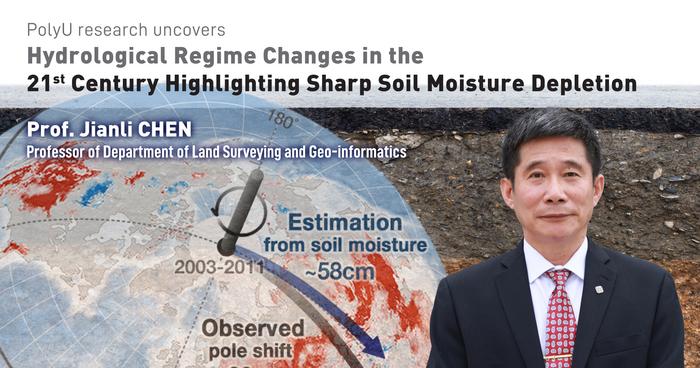The depletion of soil moisture across the globe has emerged as a pressing concern in recent times, particularly as the phenomenon impacts both agricultural productivity and the overarching dynamics of sea level rise. Recent research conducted by a dedicated team from the Department of Land Surveying and Geo-informatics at The Hong Kong Polytechnic University (PolyU) has brought to light the gravity of this issue. By leveraging cutting-edge space geodetic observation technology and a comprehensive dataset on global hydrological changes, the research team has unveiled alarming trends in terrestrial water storage and soil moisture depletion, highlighting their significant contributions to rising sea levels.
Over the past four decades, patterns of land water storage have undergone considerable alterations, with the research findings indicating a rapid depletion in global soil moisture levels. This depletion has led to substantial quantities of water flowing from land into the oceans, driving up sea levels at an alarming rate. The critical insights derived from this study have been published in the esteemed journal Science, illustrating not only the research’s significance but also its relevance to ongoing discussions regarding climate change and its implications.
Historically, understanding changes in terrestrial water storage has faced considerable challenges, particularly when it comes to measuring components such as groundwater and root zone soil moisture. Such difficulties have traditionally hampered the assessment of hydrological changes at continental scales. However, the PolyU research team, in collaboration with international experts, has successfully navigated these challenges. By utilizing satellite altimetry and gravity missions like the Gravity Recovery and Climate Experiment (GRACE) and GRACE Follow-On, the researchers have enabled detailed observations of terrestrial water storage variations across continents.
One of the striking revelations of this study is the connection between the observed depletion in terrestrial water storage and the fluctuations in global sea levels. The melting of Greenland’s ice sheet has been recognized as a primary contributor to rising sea levels, accounting for an increase of approximately 0.8 millimeters annually. Yet, the research indicates that from 2000 to 2002 alone, the global terrestrial water storage experienced a significant decline, with over 1,614 billion tons of water lost to the oceans. This loss, which is reported to be double that of current contributions from Greenland ice melt, translates into an equivalent sea level rise of approximately 4.5 millimeters.
Moreover, the research indicates that the decline in soil moisture has been both abrupt and persistent. Since the early 2000s, the loss of terrestrial water storage has continued at a gradual but unrelenting pace, with no signs of recovery apparent in the short term. The impacts of this depletion are evidenced by the observed shift in the Earth’s pole—between 2003 and 2011, the pole shifted by 58 centimeters towards 93° East Longitude, a shift indicative of the mass redistribution caused by the ongoing decline in soil moisture.
The study highlights the interplay between changing climate conditions and the observed decreases in soil moisture. Factors such as precipitation deficits, stable evapotranspiration, global warming, and shifting rainfall patterns are identified as likely contributors to the observed decline in terrestrial water storage. The European Centre for Medium-Range Weather Forecasts’ ERA5-Land soil moisture data corroborates these findings, revealing substantial losses in terrestrial water storage across critical regions including Africa, Asia, Europe, and South America. The spatial impacts have been particularly pronounced, expanding from localized areas in northeastern Asia and eastern Europe to broader regions throughout Central Asia and Europe.
As the consequences of these changes unfold, agricultural practices are also evolving. Increased irrigation in regions such as northeastern China and the western United States, alongside global greening trends, raises concerns about the sustainability of soil moisture in semi-arid areas. The PolyU team emphasizes the need for improved land surface models that consider the multifaceted factors influencing long-term shifts in terrestrial water storage. Understanding these dynamics is crucial for addressing the challenges posed by climate change and ensuring sustainable water resource management.
Professor Jianli Chen, a leading member of the research team, stresses the significance of integrating various modern space geodetic observations. He highlights that accurate measurements of sea level changes alongside variations in Earth’s rotation serve as critical indicators of large-scale mass changes within the Earth system. By interlinking these observations, researchers can derive comprehensive analyses of the driving factors behind both terrestrial water storage dynamics and resultant sea level rise.
The implications of these findings extend beyond academia, offering data and insights valuable for policymakers and climate scientists alike. As global hydrological cycles begin to reflect more pronounced changes, the research underscores the necessity of developing strategies that address the impending challenges related to drought and resource management. Collaboration among experts from multiple disciplines is essential to formulate effective solutions that can mitigate the impacts of climate change, ensuring that society can navigate the complexities of a changing planet.
In conclusion, the urgent call to action is clear—understanding the dynamics of soil moisture depletion and its relationship with rising sea levels is essential for preparing for the impacts of climate change. The insights gained from this research not only contribute to scientific discourse but also serve as a guiding beacon for future studies and policy recommendations aimed at safeguarding our water resources and addressing the broader implications of climate change.
Subject of Research: Depletion of soil moisture and its impact on rising sea levels
Article Title: Abrupt sea level rise and Earth’s gradual pole shift reveal permanent hydrological regime changes in the 21st century
News Publication Date: 27-Mar-2025
Web References: Science Journal
References: N/A
Image Credits: © 2025 Research and Innovation Office, The Hong Kong Polytechnic University. All Rights Reserved.
Keywords
Sea level rise, soil moisture, climate change, hydrology, agricultural practices, water resource management.
Tags: agricultural productivity impactsclimate change implicationsenvironmental impact of soil depletiongeo-informatics in climate researchglobal hydrological changesland water discharge into oceansPolyU soil moisture studysea level rise researchsoil moisture declinespace geodetic observation technologyterrestrial water storage patternswater flow from land to sea





